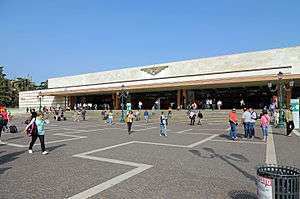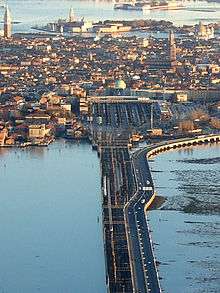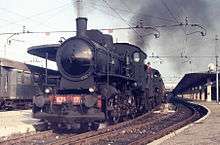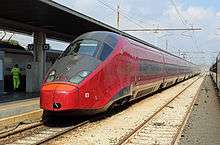Venezia Santa Lucia railway station
Venezia Santa Lucia | |
|---|---|
| Railway Station | |
 Venezia Santa Lucia railway station | |
| Location |
Fondamenta Santa Lucia, 30121, Venice, Veneto Italy |
| Coordinates | 45°26′27″N 12°19′15″E / 45.44083°N 12.32083°ECoordinates: 45°26′27″N 12°19′15″E / 45.44083°N 12.32083°E |
| Owned by | Rete Ferroviaria Italiana |
| Operated by |
Grandi Stazioni (Station) Trenitalia (Train services) |
| Line(s) |
Milan–Venice railway Venice–Trieste railway Venice–Udine railway Trento–Venice railway |
| Platforms | 16 |
| Other information | |
| Classification | Platinum[1] |
| History | |
| Opened | 1861 |
| Location | |
 Venezia Santa Lucia Venezia Santa Lucia (Northern Italy) | |

Venezia Santa Lucia (Italian: Stazione di Venezia Santa Lucia) is a terminal railway station serving the city of Venice, Italy. It is also the only (heavy rail) railway station in the historic city of Venice (Italian: Centro storico), although there are also three light rail stations on the Venice People Mover network.
The station is one of Venice's two most important railway stations, the other one being Venezia Mestre, a junction station in Venice's mainland frazione of Mestre. Both stations are managed by Grandi Stazioni and they are linked with each other by the Ponte della Libertà (English: Liberty Bridge) between the mainland and the historic city.
Location
Venezia Santa Lucia is located in Cannaregio, the northernmost of the six historic sestieri (districts) of the historic city, near the western end of the Grand Canal. It lies at the 267 kilometres (166 mi) mark of the Milan–Venice railway.
A bridge over the Grand Canal, the Ponte degli Scalzi (or Ponte dei Scalzi) (English: Bridge of the Barefoot [Monks]), links the concourse in front of the station with the sestiere of Santa Croce.
Since 2008, the concourse has also been linked with Piazzale Roma, the car terminal in the historic city and main terminus for all bus routes in and out of Venice, and by another Grand Canal bridge, the controversial Ponte della Costituzione (English: Constitution Bridge).
History


.jpg)
Construction of the Santa Lucia station began in 1860. In order to make room for both the station and its forecourt, a convent and the Church of Santa Lucia were demolished in 1861. The station, in turn, took up the name of the church.
The current station building is one of the few modernist buildings facing the Grand Canal. It is the result of a series of plans started up by the rationalist architect Angiolo Mazzoni in 1924 and developed by him over the next decade.
In 1934, a contest for a detailed design for the current station was won by Virgilio Vallot. Between 1936 and 1943, Mazzoni and Vallot collaborated on the construction of the station building, whereas Mazzoni also designed the train hall. This work, however, was completed only some years later, in 1952, on a design developed by another architect, Paul Perilli.[2]
In November 2009, work began on the renovation of the station. The renovation programme would include improvements to the use of spaces and the flow of internal transit. Additionally, certain architectural elements will be recovered and restored; the atrium will be altered to house several retail spaces. This project is estimated to take two years and cost 24 million euros.[3][4]
Features
As the current station building is low and wide, it does not dominate its surroundings. The flanks of its façade are decorated with Venetian lions. Behind the façade, there is a sizeable main hall with ticketing facilities, shops, offices and luggage storage facilities. The main hall also leads to the station's 16 platforms.
Train services
The station is served by the following services:
- High speed services (Frecciarossa) Salerno - Naples - Rome - Florence - Bologna - Padua - Venice
- High speed services (Italo) Salerno - Naples - Rome - Florence - Bologna - Padua - Venice
- High speed services (Frecciargento) Naples - Rome - Florence - Bologna - Padua - Venice
- High speed services (Frecciargento) Rome Airport - Rome - Florence - Bologna - Padua - Venice
- High speed services (Frecciabianca) Turin - Milan - Verona - Padua - Venice
- High speed services (Frecciabianca) Lecce - Bari - Ancona - Rimini - Padua - Venice
- Intercity services (EuroCity) Munich - Innsbruck - Verona - Padua - Venice
- Intercity services (EuroCity) Geneva - Lausanne - Brig - Milan - Verona - Padua - Venice
- Intercity services (EuroCity) Vienna - Klagenfurt - Villach - Udine - Treviso - Venice
- Night train (Thello) Paris - Milan - Verona - Padua - Venice
- Night train (CityNightLine) Munich - Tarvisio - Udine - Treviso - Venice
- Night train (EuroNight) Vienna - Linz - Salzburg - Villach - Udine - Treviso - Venice
- Night train (Intercity Notte) Rome - Bologna - Venice - Udine - Trieste
- Tourist train (Venice-Simplon Orient Express) London Paris - Munich - Innsbruck - Venice
- Express services (Regionale Veloce) Bologna - Ferrara - Rovigo - Padua - Venice
- Express services (Regionale Veloce) Verona - Vicenza - Padua - Venice
- Express services (Regionale Veloce) Trieste - Cervignano del Friuli - Portogruaro - Venice
- Express services (Regionale Veloce) Trieste - Gorizia - Udine - Treviso - Venice
- Regional services (Treno regionale) Ferrara - Rovigo - Monselice - Padua - Venice
- Regional services (Treno regionale) Verona - Vicenza - Padua - Venice
- Regional services (Treno regionale) Trieste - Gorizia - Udine - Treviso - Venice
- Regional services (Treno regionale) Bassano del Grappa - Castelfranco Veneto - Venice
- Local services (Treno regionale) Portogruaro - Venice
- Local services (Treno regionale) Adria - Piove di Sacco - Venice
Traffic
The station is used by about 82,000 passengers per day, or a total of around 30 million passengers per annum.[2]
Every day, approximately 450 trains stop at the station.[2] Long-distance trains use the central platforms, and the regional and suburban platforms are located to the west.
The station is the terminus of several famous trains, including the Venice Simplon Orient Express.
Interchange
Overview
The station is connected with the rest of Venice by the Vaporetto (public water bus) or private water taxi boats. The nearby Piazzale Roma is the departure point for all car services and taxis for the mainland.
Vaporetto lines in the transit station
The stop (dock) is called Ferrovia and is served by eight ACTV Vaporetto lines:
- 1 P.le Roma - Ferrovia - Rialto - San Marco - Lido
- 2 San Zaccaria - Giudecca - Tronchetto - P.le Roma - Ferrovia - Rialto - San Marco - (Lido)
- 4.1 Murano - F.te Nove - Ferrovia - P.le Roma - Giudecca - San Zaccaria - F.te Nove - Murano
- 4.2 Murano - F.te Nove - San Zaccaria - Giudecca - P.le Roma - Ferrovia - F.te Nove - Murano
- 5.1 Lido - F.te Nove - Ferrovia - P.le Roma - San Zaccaria - Lido
- 5.2 Lido - San Zaccaria - P.le Roma - Ferrovia - F.te Nove - Lido
- DM Murano - Ferrovia - P.le Roma - Tronchetto
- N San Zaccaria - Giudecca - Tronchetto - P.le Roma - Ferrovia - Rialto - San Marco - Lido (night line)
See also
- History of rail transport in Italy
- List of railway stations in Veneto
- Rail transport in Italy
- Railway stations in Italy
References
- ↑ List of Italian stations and categories
- 1 2 3 "Venezia S. Lucia". Grandi Stazioni official website. Grandi Stazioni. Retrieved 8 October 2010.
- ↑ "Venezia S. Lucia - New project". Grandi Stazioni official website. Grandi Stazioni. Retrieved 8 October 2010.
- ↑ "Al via i lavori di restyling della stazione ferroviaria di Santa Lucia." [Work begins on the restyling of Santa Lucia station.]. Comune Venezia official website (in Italian). Comune Venezia. Retrieved 8 October 2010.
External links
![]() Media related to Venezia Santa Lucia at Wikimedia Commons
Media related to Venezia Santa Lucia at Wikimedia Commons
- "Grandi Stazioni SpA" official website
- Stazioni del Mondo - Description and images of Venezia Santa Lucia station (Italian)
| ||||||||||||||
| ||||||||||||||||||||||||
| ||||||||||||||||